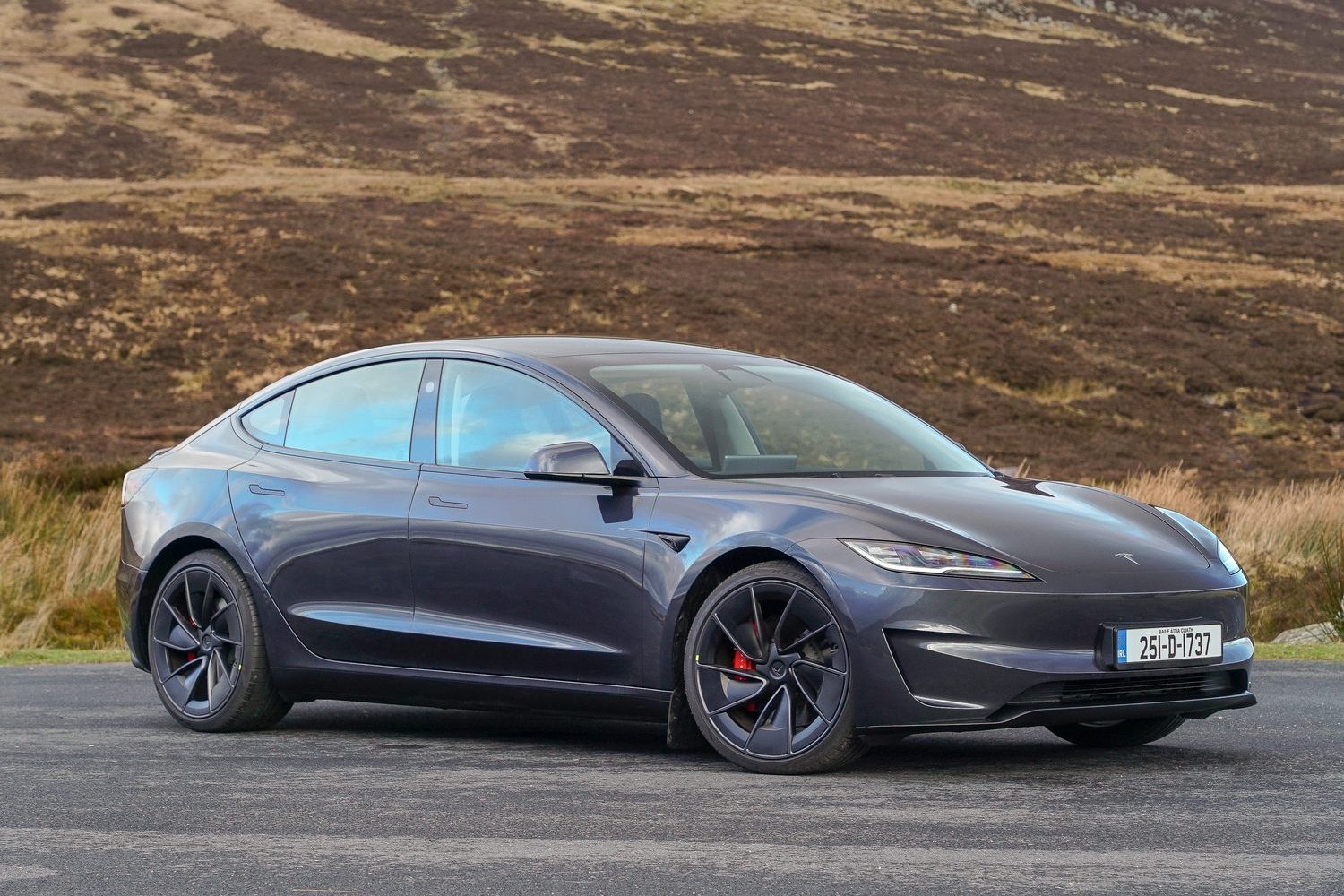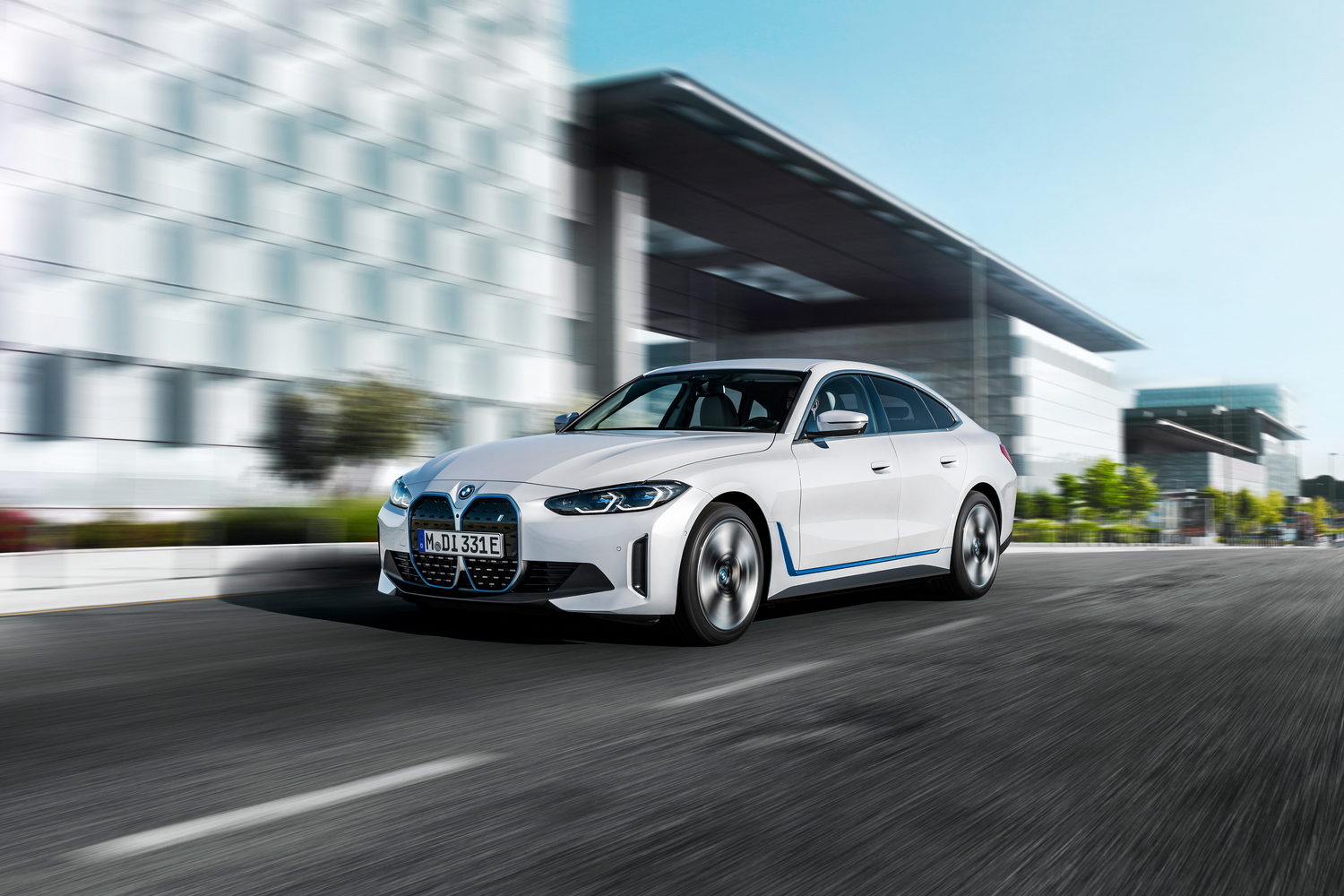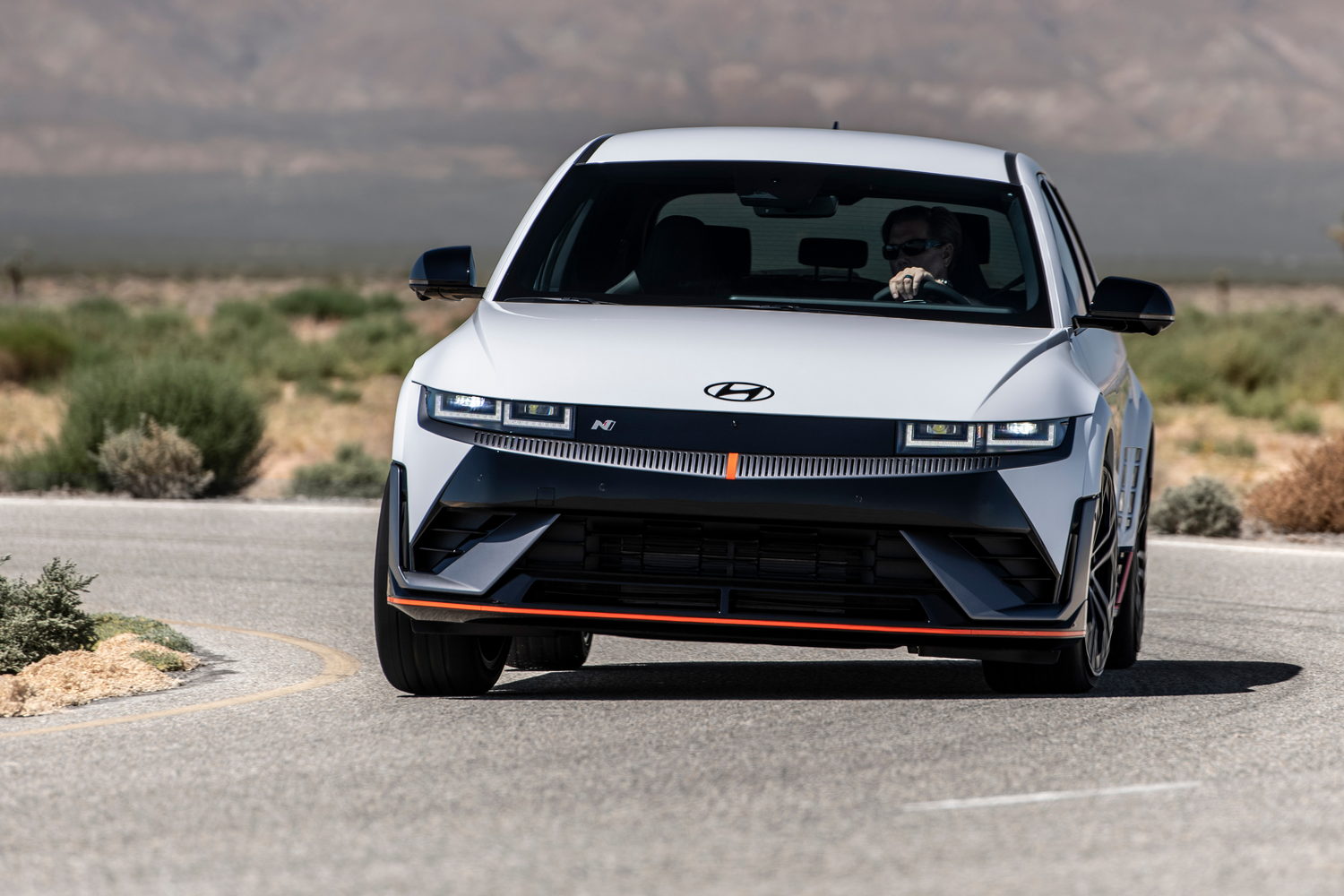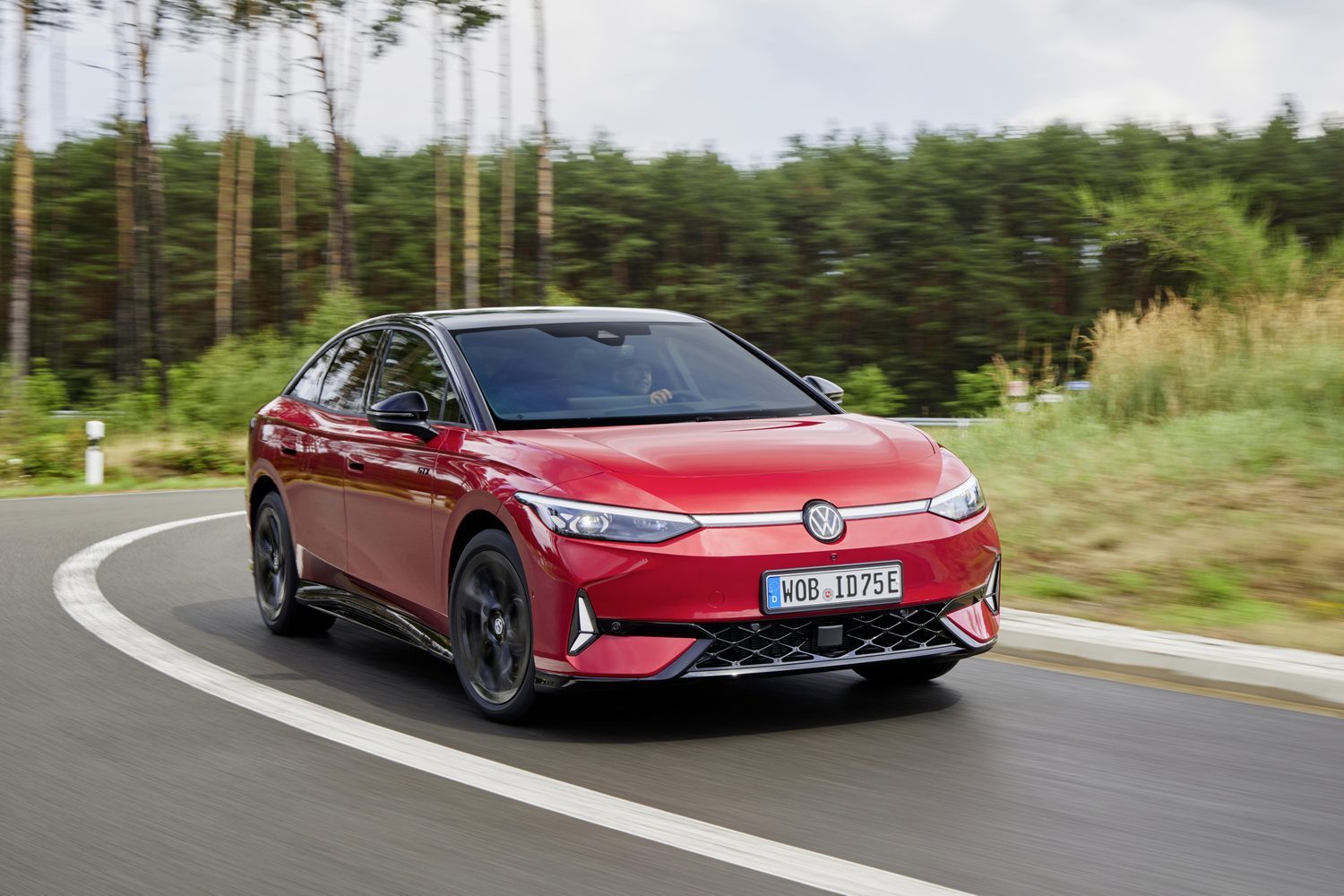Introduction to the 2025 Tesla Model 3 Performance
The 2025 Tesla Model 3 Performance is the most driver-focused version of the updated “Highland” Model 3. It gets more power, a significantly revised chassis, bespoke aerodynamics, a Track Mode and a few unique bits and pieces inside and out to help it stand out from the regular models.
It has a lot to live up to, and straight-line performance alone won’t cut it in a modern-day EV designed to appeal to driving enthusiasts.
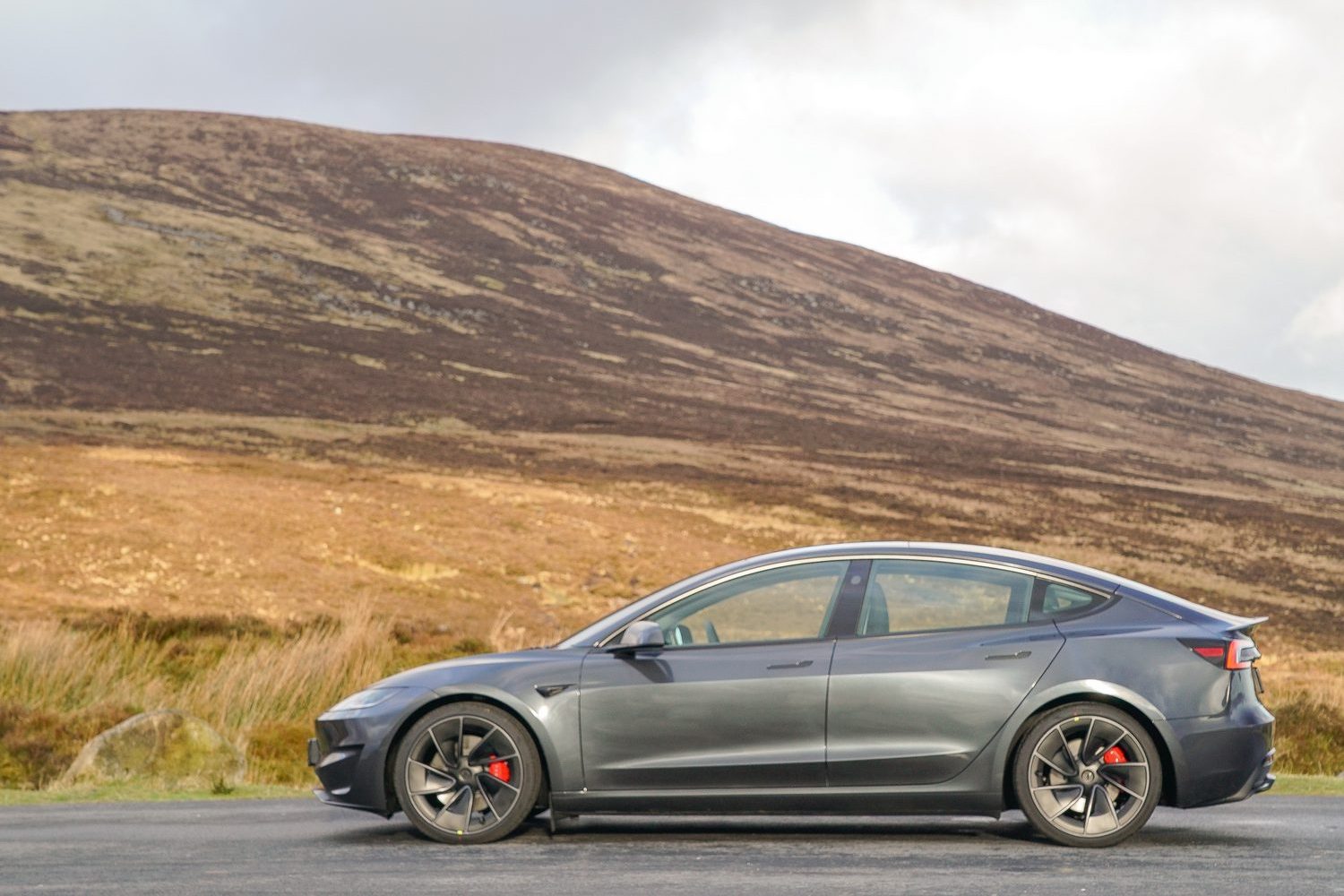
Given how much we liked to drive the original Model 3 Performance, and despite the behaviour of Tesla’s head honcho, we were looking forward to some time spent on familiar Irish test roads in the new one.
Pros & Cons of the 2025 Tesla Model 3 Performance
Pros: Supercharger network, terrific value for the performance
Cons: Poor damping and body control, a bit soulless
Exterior & Design of the 2025 Tesla Model 3 Performance
• Aero updates for the Performance model
• The Model 3 is about the same size as a BMW 3 Series
• Bespoke wheels and lower ride height
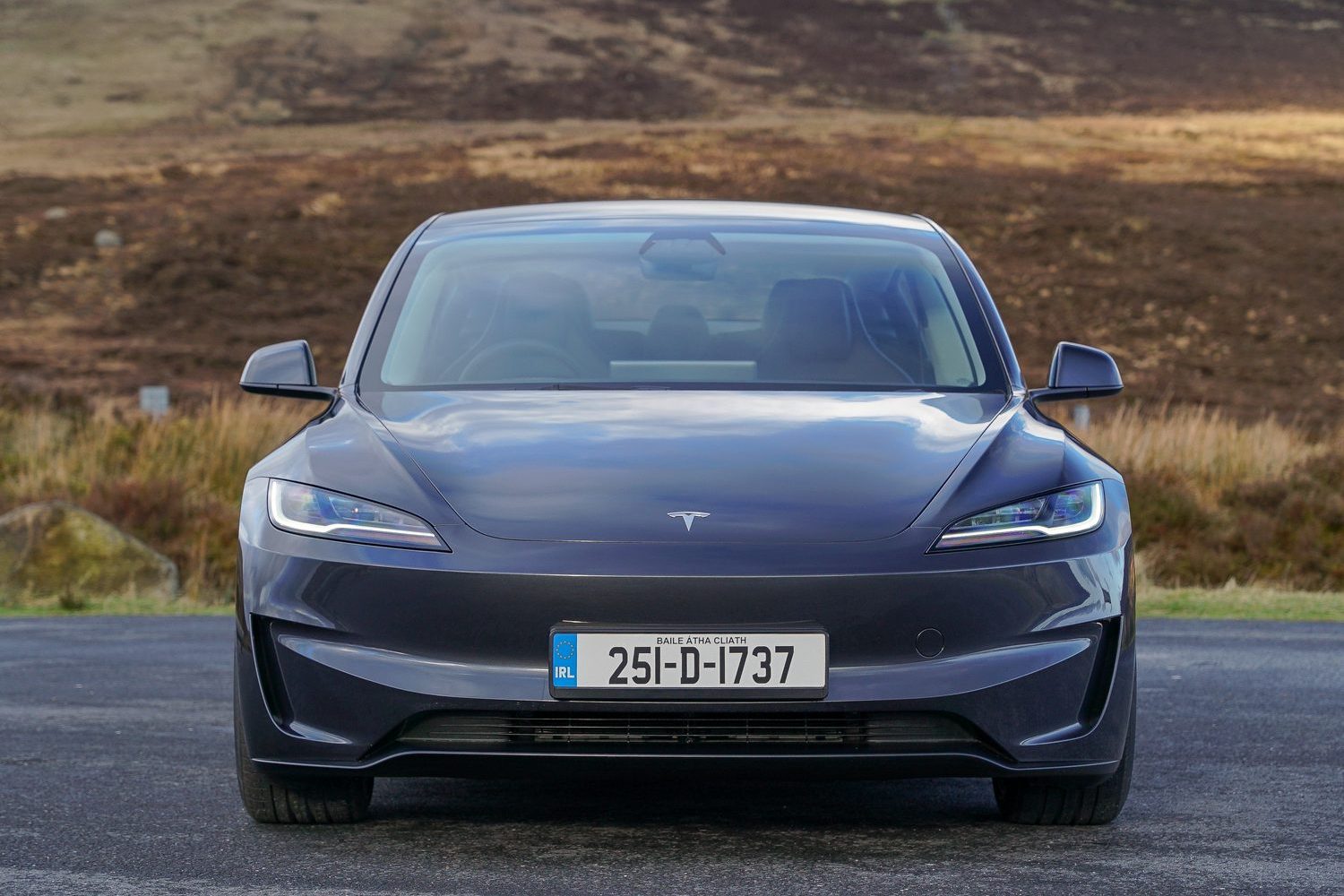
The Tesla Model 3 was comprehensively overhauled in 2023, including an update to the saloon’s exterior in the name of both freshening up the design and enhancing the aerodynamics. Tesla doesn’t quote an official drag coefficient for the Performance variant, but the standard Model 3 has a figure as low as 0.219, making it one of the most aerodynamic cars in its class.
Viewed from the side, it’s unmistakably a Model 3, with a flowing roofline that merges seamlessly into the rear deck. Frameless windows and flush door handles maintain the clean, minimalist aesthetic (and yes, the exterior door handles are still infuriating to use), while new 20-inch forged alloy wheels, exclusive to the Performance model, work with the lower ride height for a notably more muscular stance.
The overall effect is subtle, especially in the ‘Stealth Grey’ paint of our test car but look closer and you’ll see there’s a small carbon-fibre boot spoiler, a more pronounced rear diffuser under the car and a new front bumper as well.
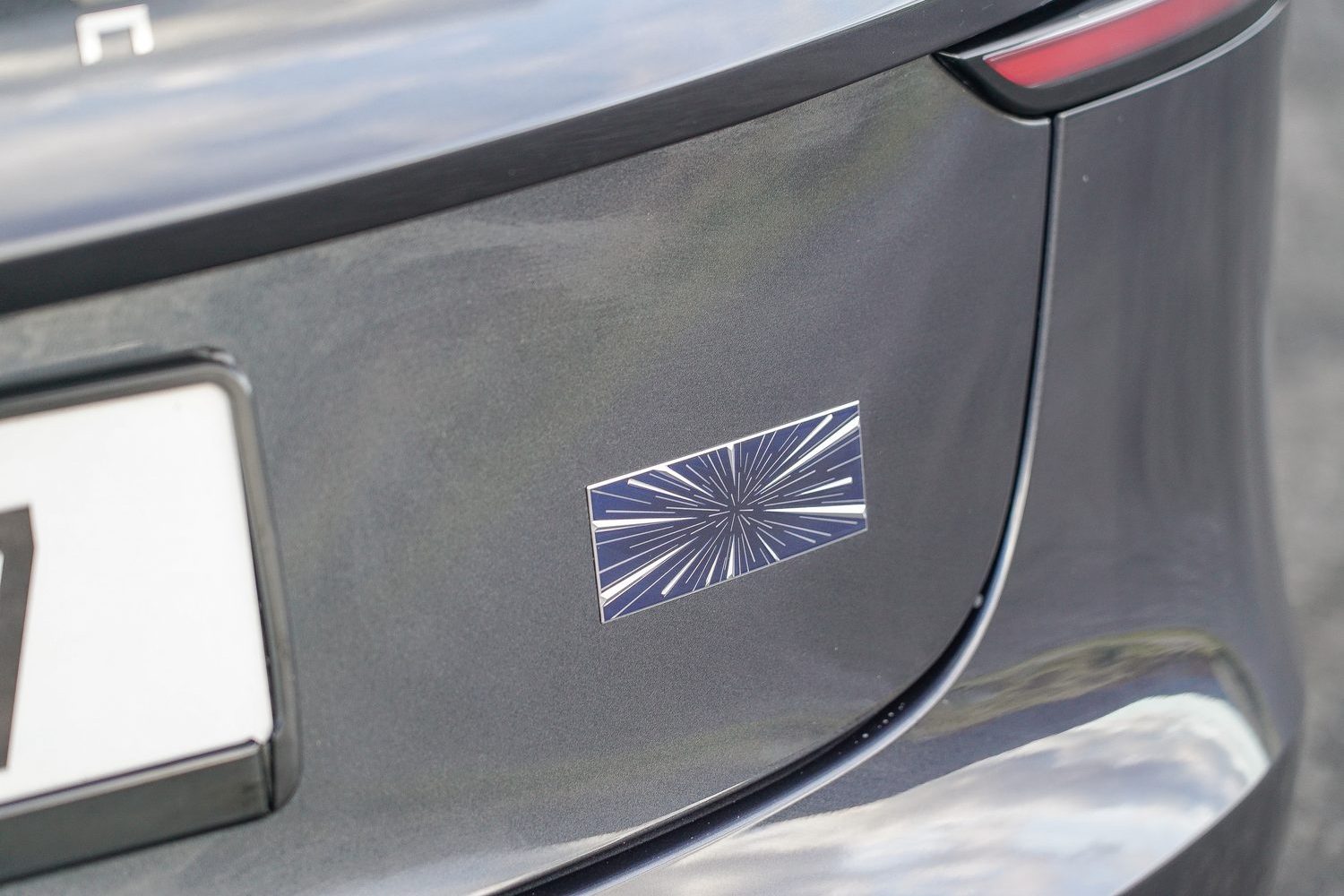
In terms of overall dimensions, the Model 3 is very similar in size to the BMW 3 Series saloon, and hence the electric BMW i4 fastback. The Model 3 sits between the slightly smaller Polestar 2 and the longer Hyundai Ioniq 6, while the Porsche Taycan is considerably larger.
For reference, the key dimensions of the Tesla Model 3 Performance are:
Length: 4,724mm
Width: 1,933mm (mirrors folded)
Height: 1,431mm
Wheelbase: 2,875mm
If buyers want any paint colour other than white, they need to pay extra: it’s €1,300 for blue, black or grey, and €2,000 for the new ‘Ultra Red’ or ‘Quicksilver’ hues.
Interior, Practicality, Tech & Comfort of the 2025 Tesla Model 3 Performance
• Awful indicator buttons on steering wheel
• Large luggage volume
• Minimal design, good quality
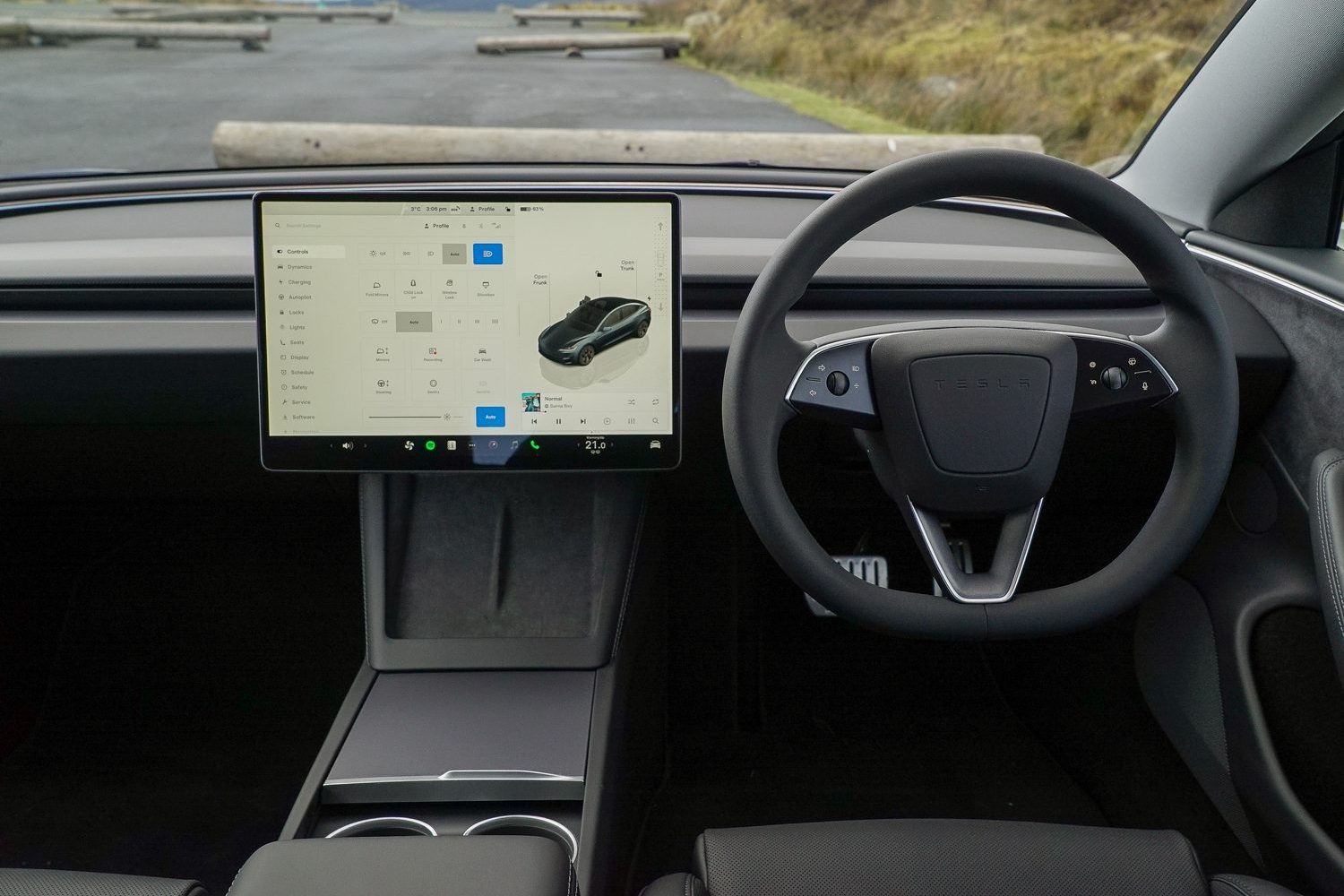
As in the regular Model 3 models, the interior of the Performance model is, we feel, blighted by a few key items, though the overall quality and selection of materials, fit and finish have taken a marked step up from the original.
Unfortunately, Tesla did away with steering column stalks completely. Selecting drive isn’t such an issue, even if it’s a bit odd to do it through the touchscreen, and the button for the wipers on the steering wheel is fine as well, but the indicator buttons are disastrous. No matter how much you get used to them, there are times where they are nigh on impossible to use correctly, for example on the exit of roundabouts.
We did notice that the new Model Y has an indicator stalk, so hopefully Tesla has seen sense and won’t continue with the button idea after this.
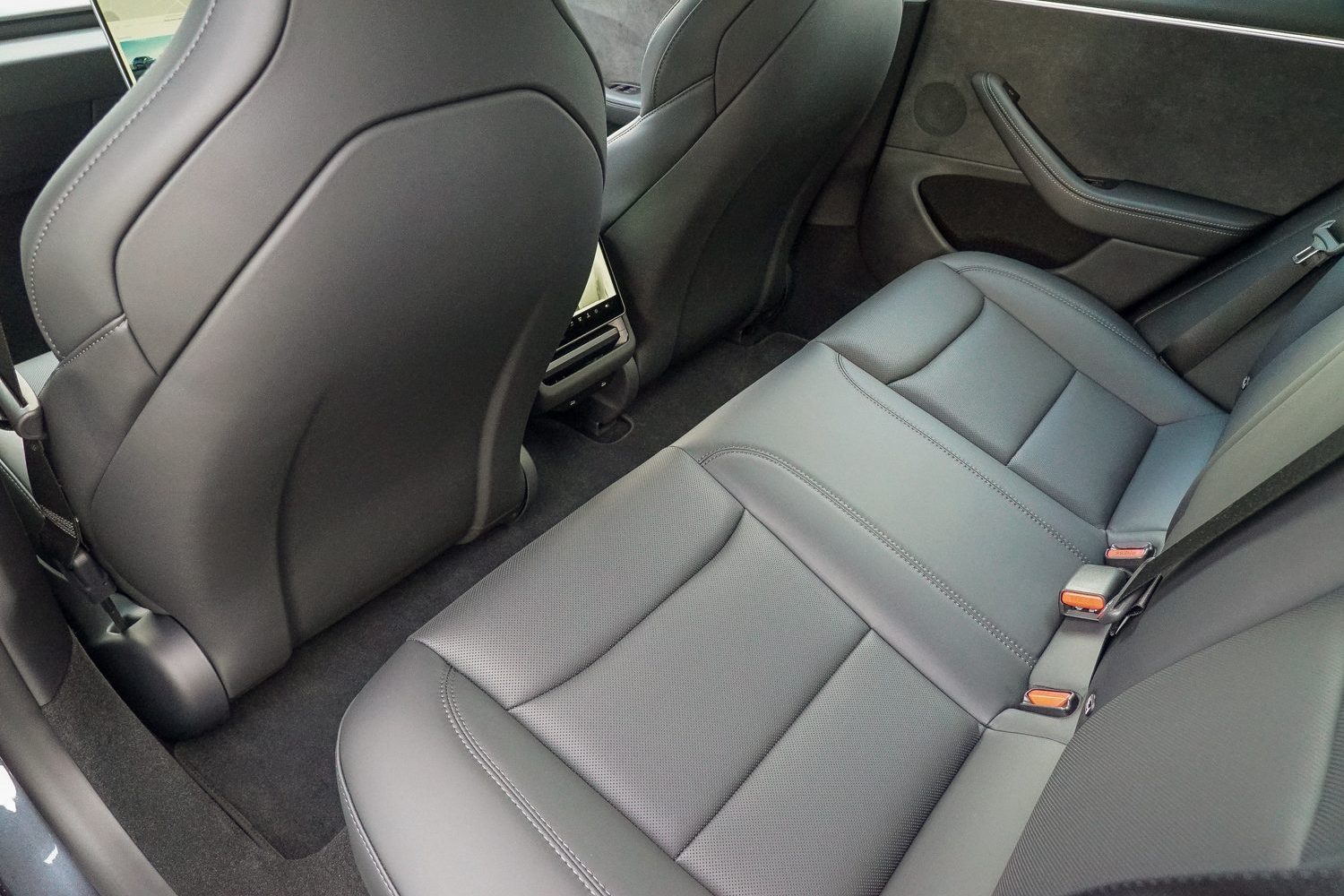
It's a shame there’s no head-up display in the car to show speed and other items, as you have to keep an eye on the large 15.4-inch display in the centre of the car instead. All Teslas are just a little too dependent on their touchscreens for our liking, and yes, there is voice control, but none of that makes up for the lack of physical switchgear. The BMW i4’s interface is far superior because it has a mix of both.
Some buyers will also be disappointed by the lack of Apple CarPlay or Android Auto - they're not even available as an optional upgrade.
Admittedly, the screen’s software runs smoothly and quickly, and kids will love it as it’s packed with gimmicks such as the fart noise generator and Christmas mode, but we suspect the novelty of all these extras will soon wear off and it’s no longer the only car on the market with built-in games. We do like that rear-seat passengers get their own eight-inch touchscreen, though.
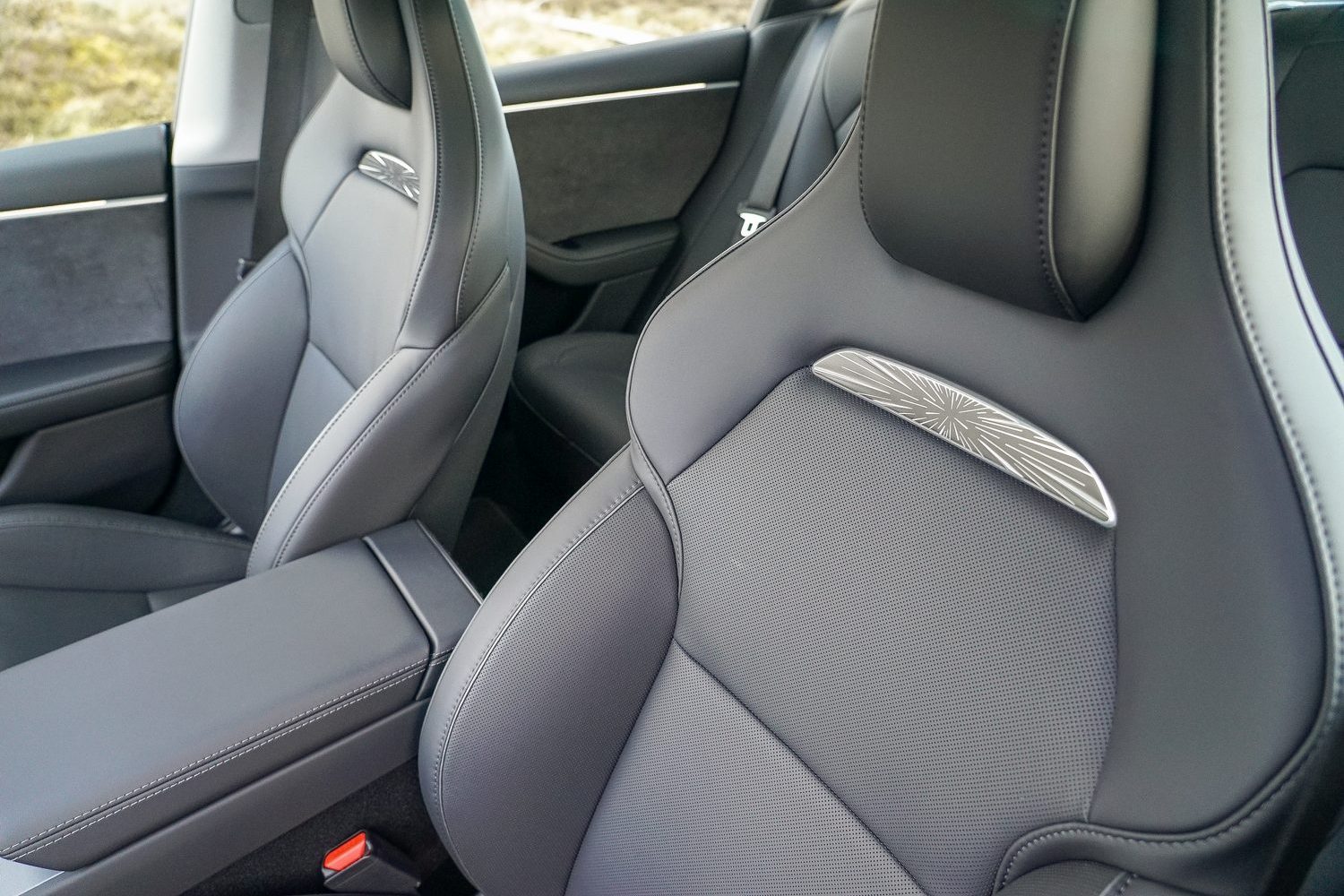
And those in the back are generally well-catered for in terms of space, thanks in part to a flat floor, though don’t expect it feel as spacious as a Model Y, for example. The rear seat base is quite sculpted - to the benefit of those sitting in the outer two positions - meaning the centre seat is narrow, raised and not very comfortable. It’s better than the BMW i4 back there, but the Volkswagen ID.7 is far more spacious and comfortable.
There’s no chance you’d get a child booster or seat into the middle of the back of the Model 3, though there are the expected ISOFIX mountings in the outer seats. The glass roof above lets plenty of light in, thankfully.
Those rear-seat backs split 60:40 and fold down flat for those times you need to carry something really long, but the Model 3’s boot is large by the sector standards. Tesla quotes a capacity of 594 litres including a notably large under-floor area, though the saloon-style boot opening does limit access a little in comparison to the hatchback shapes of the i4 and ID.7. An added bonus for Model 3 owners is that there’s a large 88-litre storage area under the bonnet up front as well.
On the subject of practicality, we dislike having to use the touchscreen to open the glovebox, but the centre console is large and spacious, plus the angled wireless charging pad works a treat.
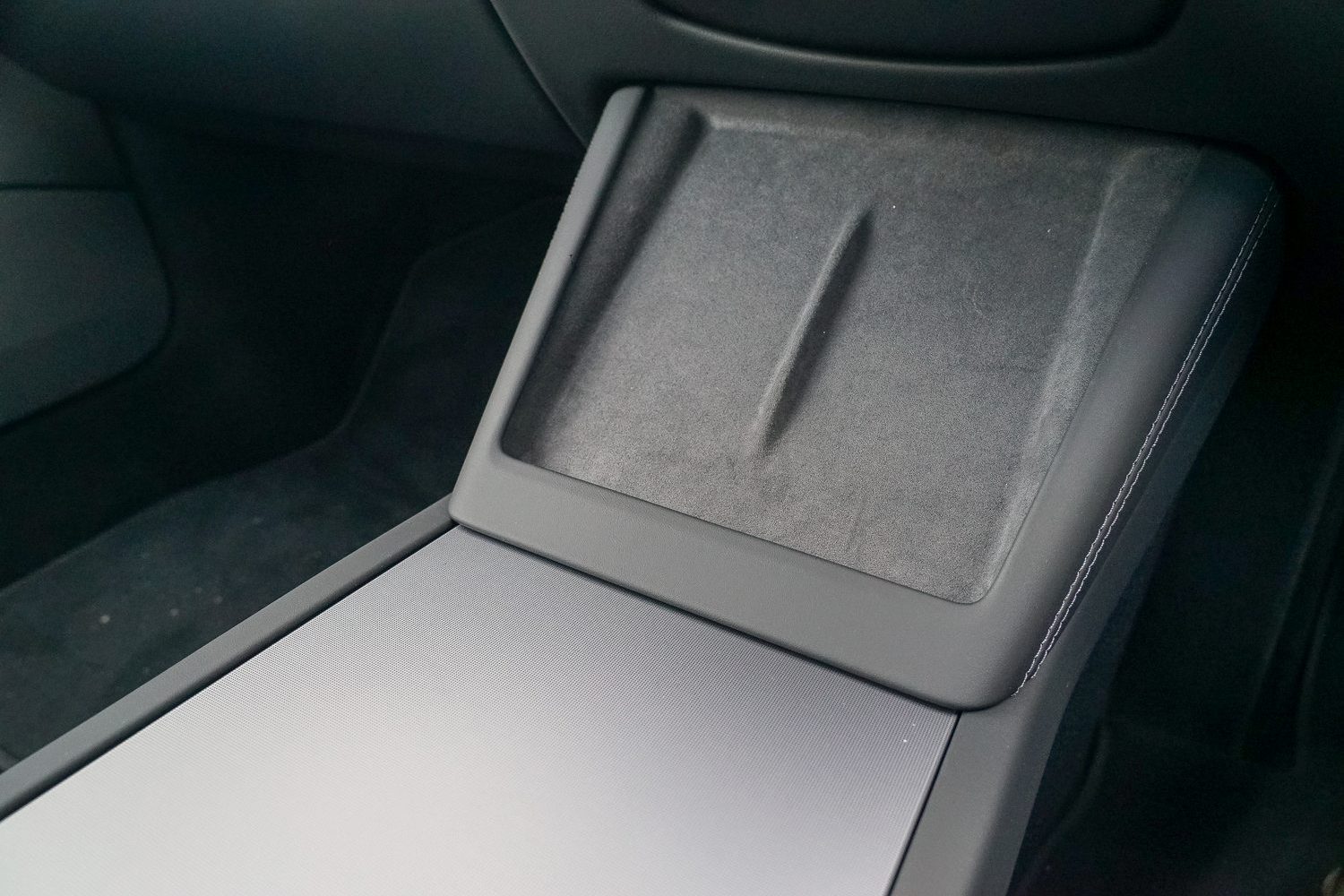
There isn’t a lot inside the Performance model to set it apart from others in the lineup, though there are a few slivers of carbon-fibre trim, and the sport seats are fabulous. They’re heated, ventilated and electrically adjustable, and while their extra bolstering is designed to hold you in place during cornering, they also prove to be exceedingly comfortable over prolonged periods of time.
There’s a decent sound system in place as well. Hidden behind the minimalist look are 17 speakers, dual subwoofers and dual amplifiers.
We can’t review a Tesla and not refer to its sometimes controversial “Autopilot” technology. As standard, the Model 3 Performance features Basic Autopilot, which is effectively adaptive cruise control with some auto-steering. Next up is Enhanced Autopilot for €3,800, which adds more functionality including auto parking and a ‘summon’ feature where you can get the car to come to you from its parking space.
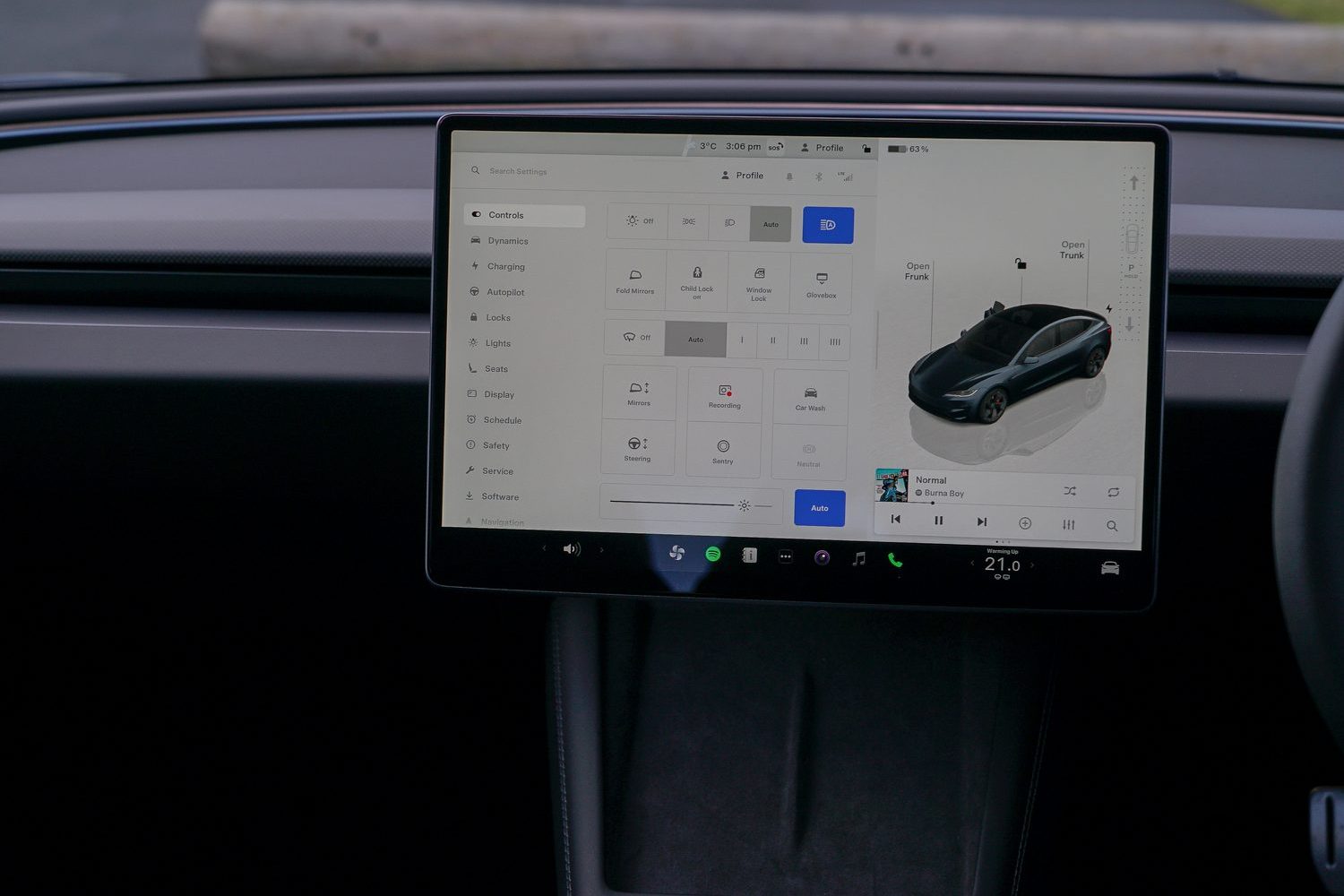
Top of the tree is the ‘Full Self-Driving Capability’ (FSD) as Tesla calls it, but buyers should be aware that it’s nothing of the sort as there is no legislation to cover such a thing in this country. It costs €7,500 and comes with the promise that “in future updates your vehicle will be able to drive itself almost anywhere with minimal driver intervention.”
Performance of the 2025 Tesla Model 3 Performance
• Two electric motors for 460hp
• Seamless all-wheel-drive traction
• Track Mode looks like fun
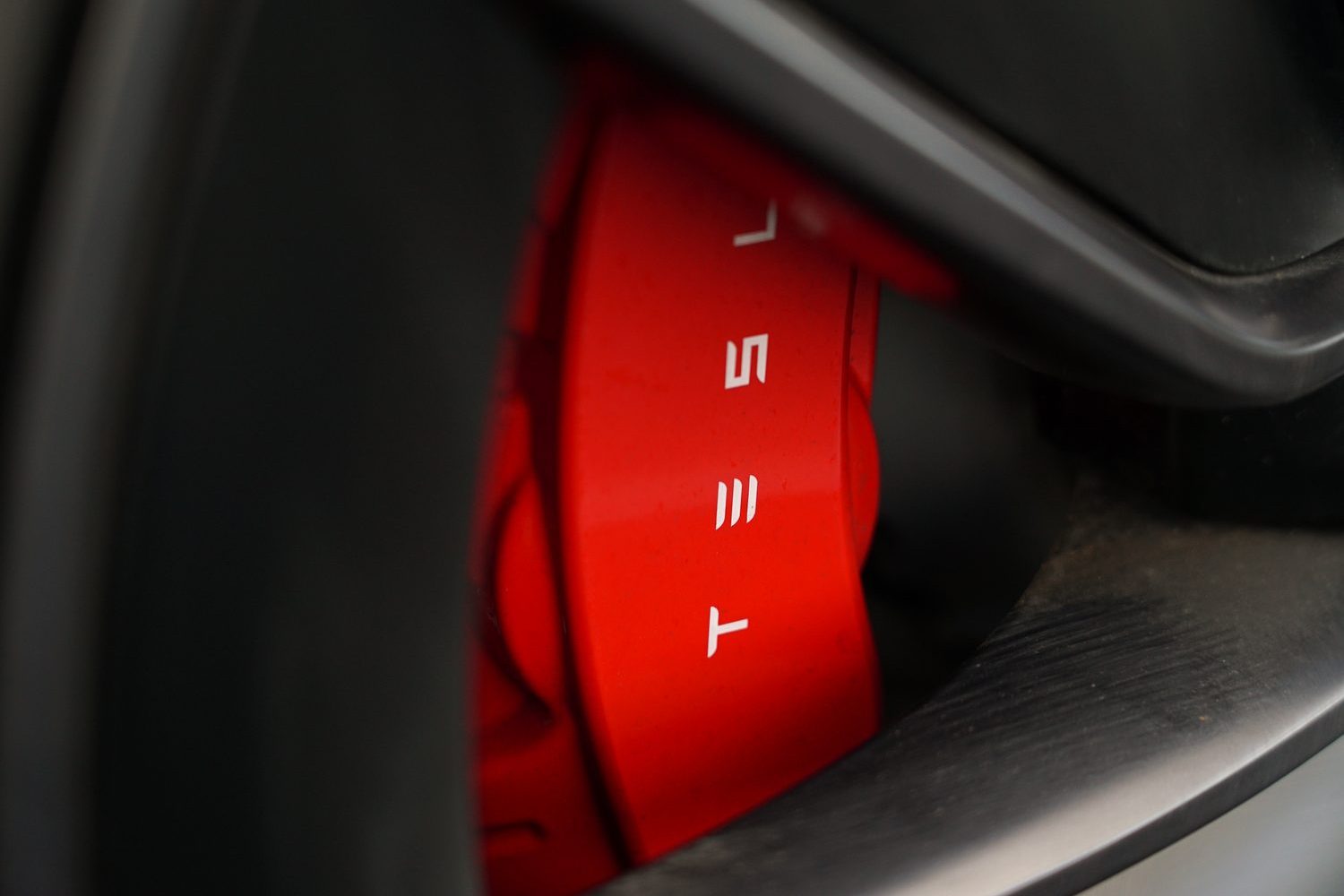
The Tesla Model 3 is available with either a single rear motor for rear-wheel drive or dual motors for all-wheel drive. Tesla is remarkably coy about the power outputs of its electric motors, but even the entry-level car has 245hp at its disposal. The Performance model lives up to its name by using a dual-motor setup producing up to 460hp and 660Nm of torque. All that allows for an official 0-100km/h time of just 3.1 seconds, and it feels incredibly quick at all times.
That sprint off the line is quite uneventful other than straining your neck muscles as the all-wheel traction ensures there’s no unseemly wheel scrabble. How urgent you’d like response to your accelerator inputs can be altered from Chill to Standard to Insane. The car is more pleasant to drive in the former two settings, unless you’re on a racetrack perhaps with your foot to the floor for sizeable portions of the lap.
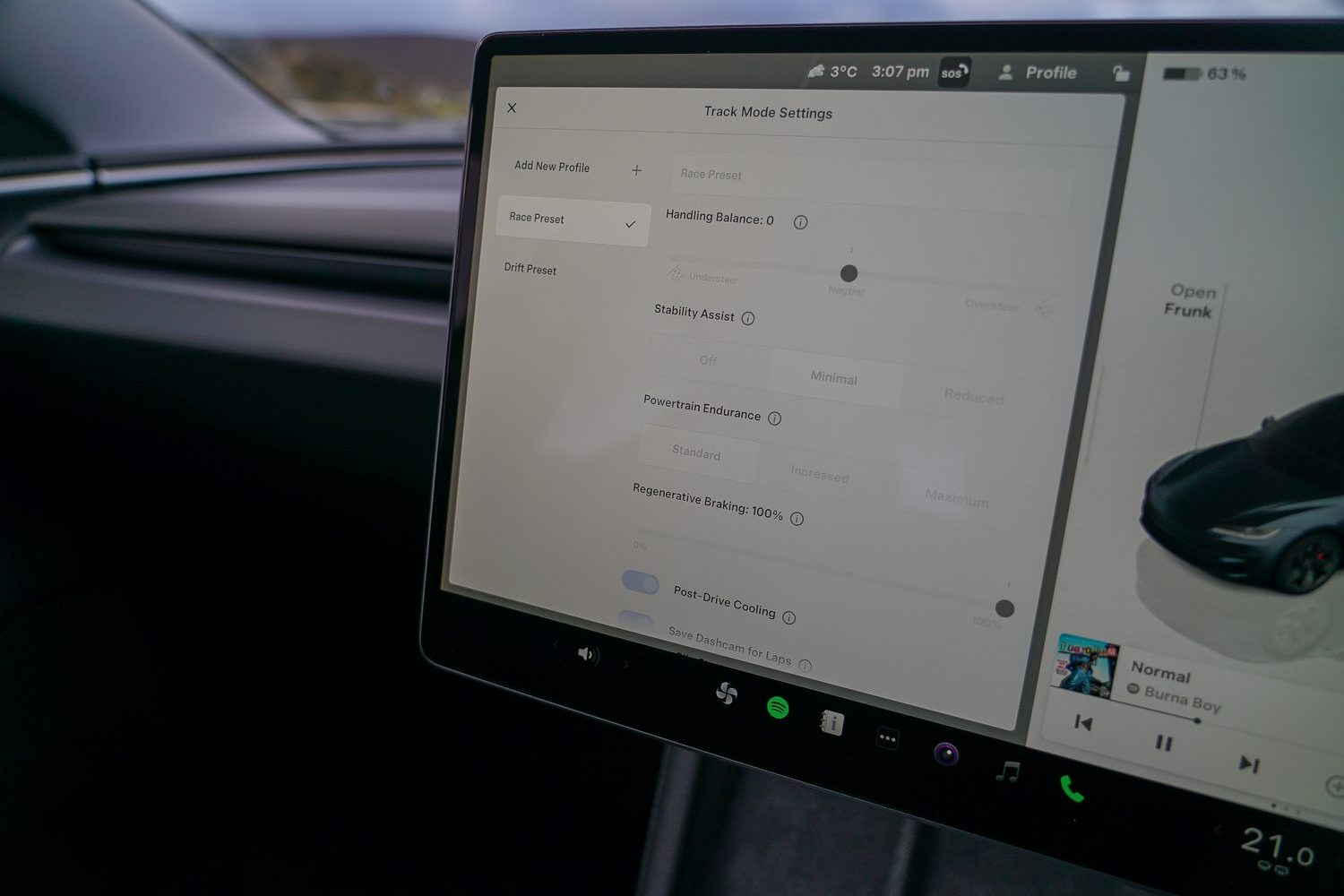
There, you’ll want to play with the Model 3 Performance’s new Track Mode. It allows customisation of the driving experience including which end of the car you’d like most of the power coming from (‘Handling Balance’); how much help you’d like from the stability control (‘Stability Assist’); whether you want to optimise lap times or being able to play on track for longer (‘Powertrain Endurance’); and how much regenerative braking you want in use. You can also select post-drive cooling so the car is ready to go back on track quicker, and set up dashcam recording of your laps onto a USB flash drive, while a lap timer and g-meter are also built into the system.
We didn’t have the opportunity to try all this on a circuit, and we suspect most buyers won’t either.
On an interesting road, however, the Model 3 Performance can be fun. The chassis has been substantially altered from that in the other versions, including beefier brakes and firmer anti-roll bars, but the biggest news is the addition of two-level adjustable damping, plus a lower ride height to lower the centre of gravity.
Impressively, the Performance rides quite well, even when you’ve selected the Sport setting for the damping. It’s firm, sure, but not in a bone-jarring way. It’s far softer and easier to live with than any BMW M car, for example. However, neither is it as engaging or as exciting to drive as a BMW M car.
The Model 3 is competent undoubtedly, and it can carry high speeds through sweeping bends if you want it to, plus the steering is pleasantly direct and the nose swiftly responds to your inputs.
If you can sense a “but” coming, it’s that we found body control to be lacking at times, conspiring with the reduced ride height to cause rubbing of bodywork over more severe undulations. We couldn’t quite get to the bottom of where the rubbing was, but it was certainly disconcerting, and it reduced our confidence in the car. Even allowing for the fact that the conditions may have been slightly outside what might be called “normal” driving, this is touted to be a performance car, and no Mercedes-AMG, BMW M or Audi RS model would have struggled in the same situation.
Range, Battery & Charging of the 2025 Tesla Model 3 Performance
• Range of up to 582km
• Fast DC charging of up to 250kW
• Excellent Supercharger network

If range is your top priority, there are better options in the Model 3 lineup - such as the Long Range Rear-Wheel Drive variant with an official range of up to 702 kilometres. Still, the Model 3 Performance manages up to 528km, which is more than adequate.
One of the major advantages of any Tesla is of course access to the company’s excellent Supercharger network of fast charging stations. They’re rarely fully occupied and it’s a truly hassle-free way to recharge when on longer journeys. The Performance model can recharge at up to 250kW on DC power, and it also manages up to 11kW on three-phase AC outlets.
Running Costs of the 2025 Tesla Model 3 Performance
• Low running costs like all electric cars
• Decent warranty on electrical components
• More efficient than most high-performance cars
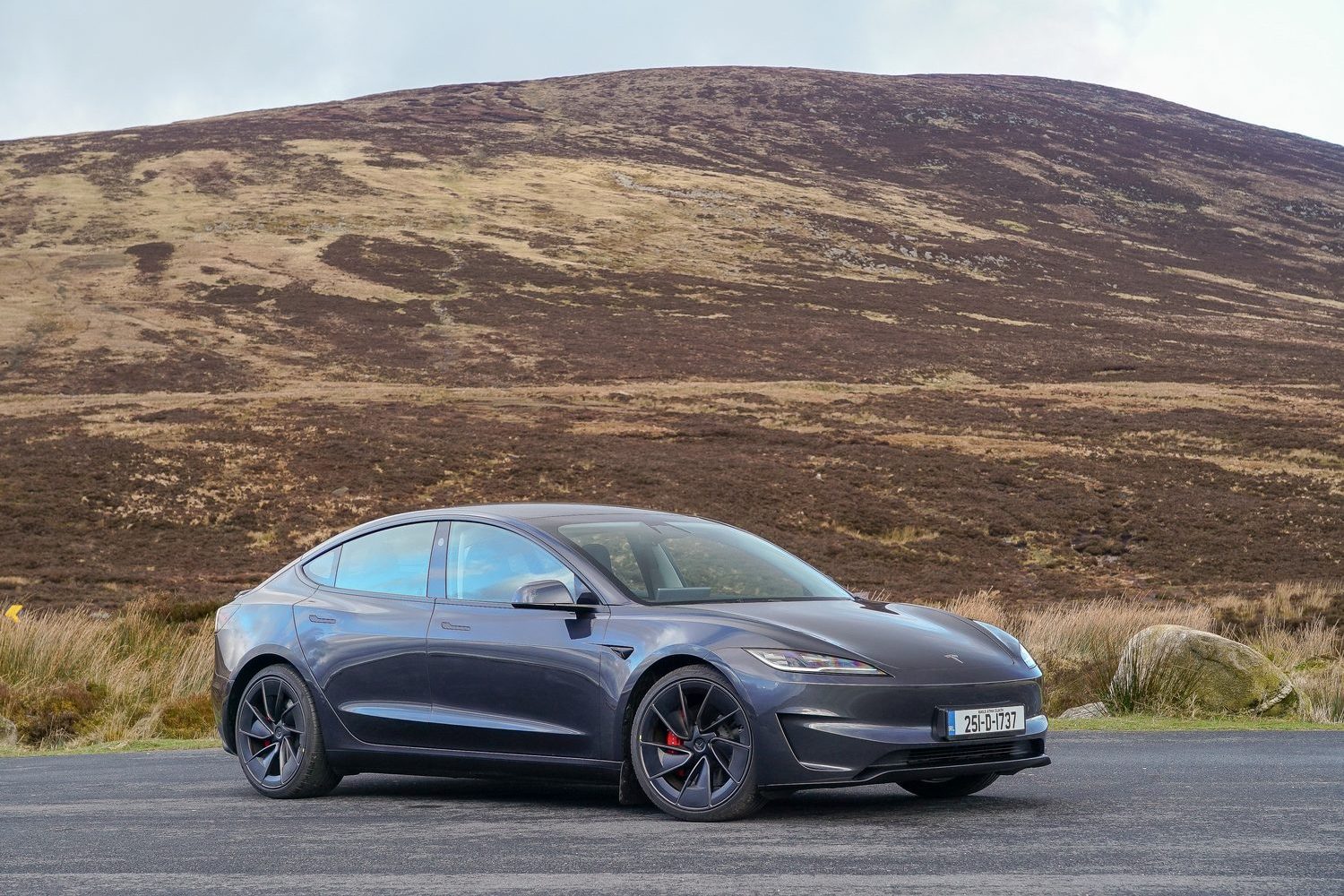
All EVs are cheap to run when compared with cars powered by engines. Not only is motor tax in the lowest bracket - at just €120 a year - but servicing costs are low as there are no regular oil changes and the like required, while brake wear is reduced as the car makes use of ‘brake energy regeneration’ through the electric motors.
Tesla quotes 16.7kWh/100km for the Performance model, which means the cost per km of driving would be significantly lower than in any comparable high-performance car with an engine. The Model 3 comes with a heat pump as standard, designed to reduce drain on the battery during colder months when you use the cabin heating more.
Obviously, you’ll not achieve that official consumption figure if you’re exploring the extra performance on tap regularly, and in our time with the car we achieved an average of in and around 21kWh/100km in a cold week.
The Tesla Model 3 Performance’s warranty package include a basic limited warranty on most of the vehicle for four years or 80,000km, five years/100,000km on the airbag system and a decent eight years or 192,000km for the battery and electric motors, guaranteeing at least 70 per cent battery capacity for that time.
Irish Pricing & Rivals of the 2025 Tesla Model 3 Performance
• Tesla Model 3 Performance starts at €65,499 in Ireland
• “Autopilot” options are expensive
• No other EV offers as much performance-per-Euro
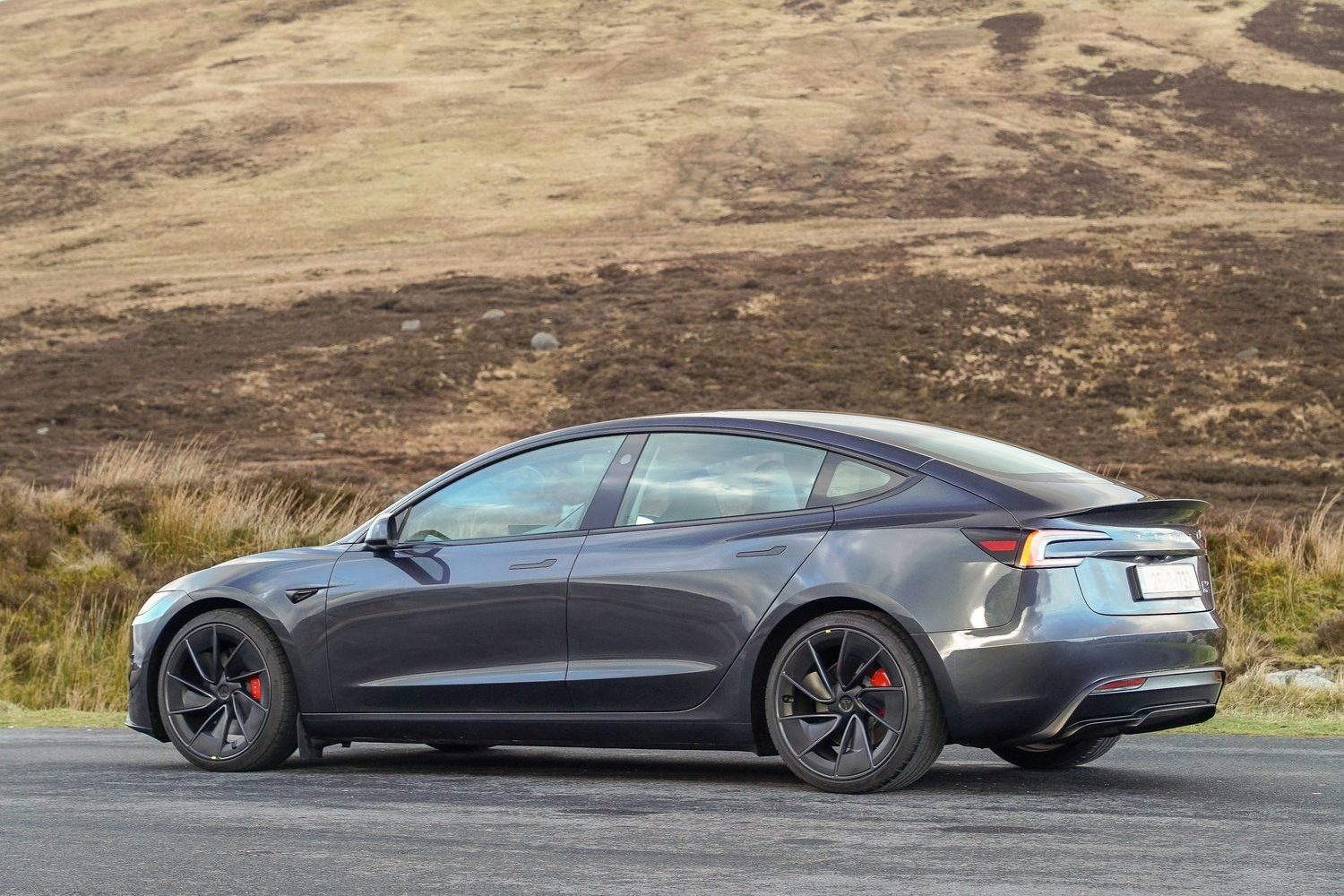
Versus a starting price of €40,984 for the entry-level Tesla Model 3, the Performance version isn’t badly priced at €65,499. Indeed, that’s only about €10,000 more than the Long Range All-Wheel Drive variant and its extra equipment warrants the premium alone, never mind the mechanical upgrades.
On the Tesla website, a car finance example for the Model 3 Performance indicates a monthly payment of €1,092 based on an APR of 6.9 per cent, deposit of €9,825 and a 36-month term. Hire purchase at the same APR over the same time period is €1,510 per month (with a €16,375 deposit). It’s easy to tweak the terms to your needs on the site.
The Tesla Model 3 Performance is a real bargain, certainly when compared to other high-performance cars. And there are few notable electric rivals with the same remit. The Volkswagen ID.7 GTX isn’t as powerful, but it justifies its higher price with a much larger cabin and really, it’s in the class above.
The Hyundai Ioniq 5 N, meanwhile, is far more driver-focused, but it’s more expensive. And this is getting repetitive, but the BMW i4, as excellent as it is, is also costlier than the Tesla, unless you consider the far less powerful eDrive35 variant.
Verdict - Should You Buy the 2025 Tesla Model 3 Performance?
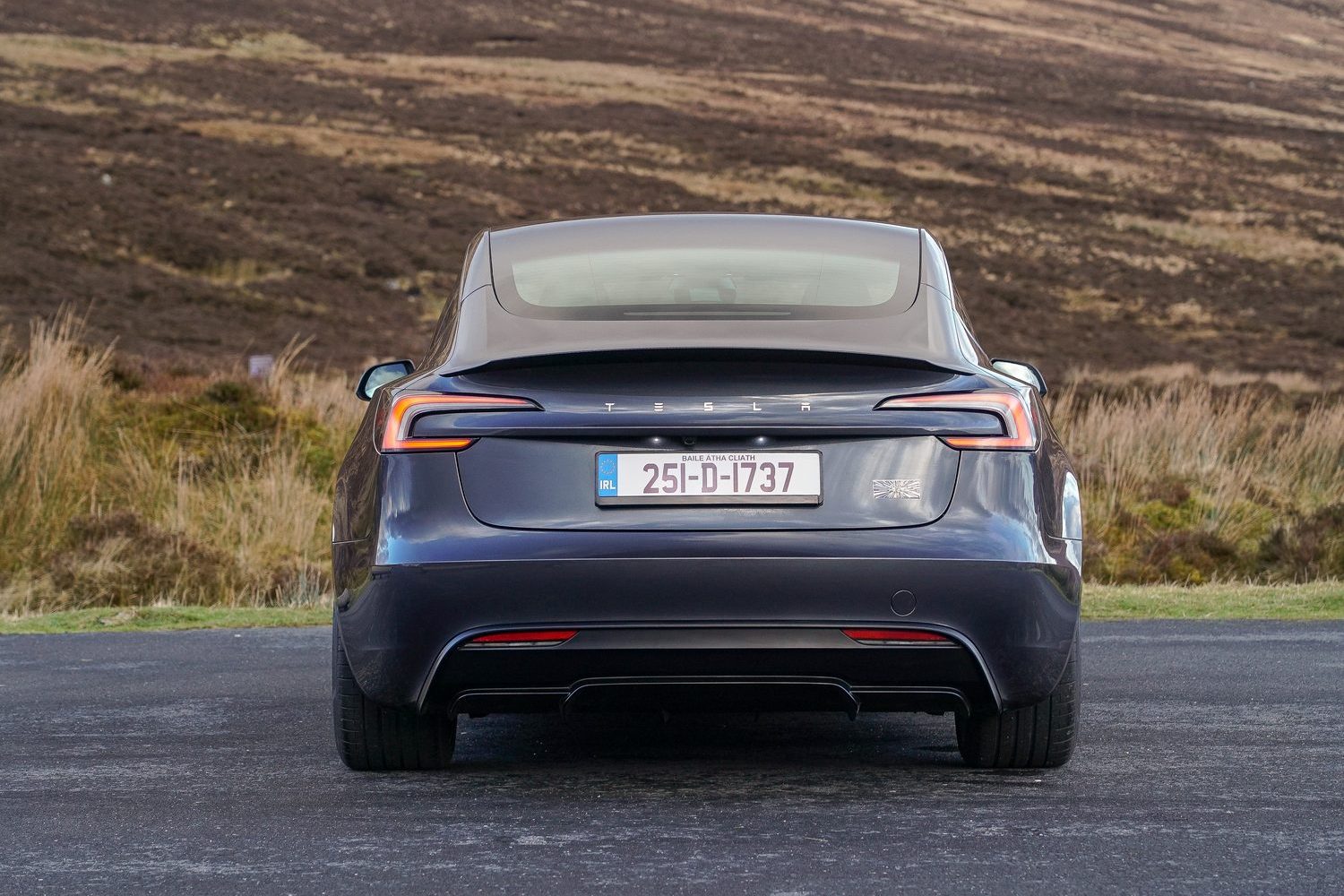
There’s a lot to like about the Model 3 Performance, especially if you’re not bothered by the antics of Tesla’s CEO and you’ve decided you like the look of the updated Model 3. It’s usefully upgraded from its predecessor; there’s no doubt about that. For those coming from traditional high-performance cars with petrol engines, its immediate pace will be appealing, but keen drivers will find it lacking in involvement and excitement beyond its g-force-creating abilities.
Nonetheless, the Model 3 now feels of high quality, it’s spacious, relatively efficient and undoubtedly lives up to the billing in Performance guise. If you just want the most interesting Model 3, then it certainly is that, and it manages it without going over the top in terms of appearance. It is, in short, a great-value, subtle high-performance EV. There aren’t many of those about. At any price.
FAQs About the 2025 Tesla Model 3 Performance
Does the Tesla Model 3 Performance have a ‘frunk’?
Yes, the space under the bonnet up front is quite large, measuring in at 88 litres.
How many child seats fit in the back of the Tesla Model 3 Performance?
Only two. There are ISOFIX points only in the two outer rear seats, as is the norm, but the central position is narrow and raised, meaning it won’t be possible to fit even a slender booster there.
Does the Tesla Model 3 Performance have a heat pump?
Yes, it does. It’s standard fit across the Model 3 lineup.
Does the Tesla Model 3 Performance qualify for the SEAI grant?
No, it does not. As the list price is over €60,000, the €3,500 SEAI grant is not available to buyers of the Tesla Model 3 Performance. Likewise, VRT must be paid for in full.
Has the Tesla Model 3 Performance been assessed for safety by Euro NCAP?
At the time of writing, no version of the updated Model 3 ‘Highland’ has been assessed by Euro NCAP. It did quite well when it was first tested in 2019, but the testing regime has moved on since then.
Want to know more about the Tesla Model 3 Performance?
If there’s anything about the Tesla Model 3 Performance we’ve not covered, or you’d like help in choosing between it and other cars, you can avail of our (completely free) expert advice service via the Ask Us Anything page.

